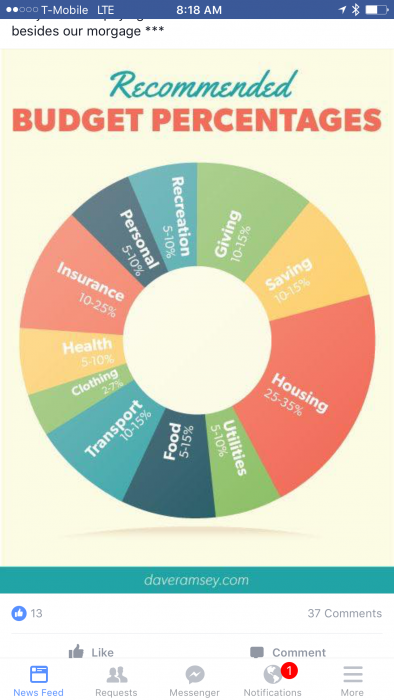by Ashley
Happy first day of March!
I hope all are doing well! I always like the first day of a new month because it feels like a mini “refresh” of some sorts. A fresh month, fresh budget, fresh chance to get it right.
And I’m in a bit of budget start-over mode over here.
I belong to a Dave Ramsey group on Facebook and took a screen shot when someone posted Dave Ramsey’s suggested budget percentages:

(I later found the image on Dave’s site HERE, just to give proper credit).
Here’s how it all breaks down:
| Recommended | |
| Housing | 25-35% |
| Saving | 10-15% |
| Insurance | 10-25% |
| Giving | 10-15% |
| Transport | 10-15% |
| Food | 5-15% |
| Utilities | 5-10% |
| Health | 5-10% |
| Personal | 5-10% |
| Recreation | 5-10% |
| Clothing | 2-7% |
| Cumulative Total | 92% – 167% |
Unfortunately, there’s such a huge range that the cumulative total ranges from 92% to 167%. That means, if I were to use this budget as a model, I’d need to stay on the low end for most of these categories.
But when I sat down and started trying to put pen to paper to see how this sample budget would work out for my household, I realized it just doesn’t. Why?
Because we still have a disgusting amount of DEBT, that’s why!
Notice there’s no “Debt” category at all in this budget! Sooooo maybe this budget is for people who are already debt-free??? Our debt takes up a huge percentage of our take-home pay (roughly a third). Plus, the budget above seems to be operating on gross pay but I typically budget using net monthly take-home pay (insurance and required retirement contributions are already withheld from my paycheck).
At any rate, this seems like a good starting point but I would love some tips or pointers! I’m really at a start-over here with our household budget, trying to make it all make sense. Now that hubs is working, a bit of the stress is off because he’s been able to pay for most of his own expenses (fuel, personal money, eating out, etc.). But we’re still not in a great financial position and I’m beyond ready to get a better handle on our finances again!
Any tips for budgeting suggestions, links to websites, books, etc., with suggested budget allocations that work for someone whose still in debt??? Is it

Hi, I’m Ashley! Arizonan on paper, Texan at heart. Lover of running, blogging, and all things cheeeeese. Freshly 40, married mother of two, working in academia. Trying to finally (finally!) pay off that ridiculous 6-digit student loan debt!


There is no category for childcare either. That has always stuck out to be with these various budget pie charts. If you are in a Situation to be paying it it takes a big chunk of your income.
I don’t have a whole lot of suggestions, but here goes. If 1/3 of your income is going to debt, you’ll have to make it work somehow with the 2/3 you have left. What are the bills you have that can’t be changed? And be honest about what can’t be changed, a utility bill can be lowered by doing more to conserve energy, you may be able to switch to a cheaper phone plan, etc. After you take those out that’s what you have left for groceries, entertainment , miscellaneous expenses, etc.
Have you done your taxes yet? I have a feeling you are still having too much withheld so I wondered how that went. Also remember when your daughters start full day school next year your childcare costs will go way down. You just have to find a way to make it till then
It’s good to see you back!
I think percentage based models are a good idea to identify target amounts for savings and housing. Beyond that they are pretty useless. Just random numbers spit out. Fact is you know your spending and expenses the best. You need to take a hard look at where you can cut back and what actions you need to do to achieve it. There’s no magic formula that will make it work. Oh other than SPEND LESS THAN YOU TAKE HOME.
When it comes to budgeting, those types of charts are not really helpful because they are so general. This chart is definitely for someone who is not deeply in debt. For you, I think you have to work backwards. Start with what you are spending now. Track every penny spent in March. Then at the end of the month, list the amount spent on each item with essentials first: Mortgage, utilities, groceries, childcare, car expenses, tax debt, student loan payments, credit cards, phones, etc. Then compare to income. If you still aren’t making enough to pay everything then you have to either make more, spend less, or both. One thing I see that is concerning is the “His” money and “my” money. You should be looking at all expenses and income as “ours”. Also, check out The Total Money Makeover to get Dave Ramsey’s full perspective on money. You are only getting bits and pieces on a Facebook group and I think you are missing out on some key components. You might also join Hope in her book club. The two of you can go through the process together. Notice where she is starting off: tracking expenses! Good luck! You can do this, it is challenging, but you CAN do this!
Good catch on the his/her money. All expenses, income, and goals should be joint. If you want to say you each get X amount of personal spending money that is fine but that should come out of joint funds. I’ve gotten the impression in the past that you handled all the bills and the stress that came with it and your husband may not even be aware of the amount of debt. You’ve said In the past you didn’t even know how much money he made. You guys need to remember you are a team in this.
Does anyone else think it’s a bit crazy to spend as much on food as you do on personal? And what IS personal? Is that the slush fund where you stash your coffees and unnecessary shopping.
Have you tried getting back into YNAB? I know it had helped you before. I’ve been using it for several year now and definitely credit it with most of the financial successes I’ve had.
I don’t think you can use a canned budget, because, as you mentioned you have unique expenses. Start with the expenses that are known – mortgage, childcare, gas, utilities, taxes, etc. and then see how much you have left. From there, budget for clothing, entertainment, unexpected, etc. Personally, I don’t even do a budget because it never works out. My idea is just to be as frugal as possible whenever possible – then track monthly after the fact to see if we are making progress. I use mint and can see over time our results by month in net worth, expenses, etc.
I second (or third) the comment that what your husband earns is not his to spend on whatever he pleases. Both you and he should have a small personal allowance, but all income goes in the common pot. I understand that in many relationships there is one who is the numbers nerd and works the budget. But that doesn’t mean the other one has his/her head in the sand and just worries about funding his/her own personal slush fund. I would fix this pronto! It’s a team effort.
While it sounds funny when you talk about your husband’s money separately, and a lot of people comment on it, you need to do what works for your relationship. If having some separation in your funds is working for you guys, then that’s what works for you. Just like the budget, every situation is different. My husband and I have almost completely separate finances, but that “almost” is a gray area that causes a lot of stress (mostly for me!)
I think you’d be better off starting from one of your previous budgets or past records from YNAB rather than a generic template. Or start with the things that can’t be changed (mortgage, childcare, etc.), slightly variable necessities, and then fill in the rest. You have a pretty good understanding of your realistic spending for the rest (groceries, personal, etc.)
I’ve been using YNAB for over 3 years. I’m still using the older version, so I don’t pay anything for it. It still works. I can’t imagine budgeting any other way now. Even if you’re not buffered, it definitely is an awesome way to see what you’re really spending and not allocate $ in more than one way. Since you’ve used it and know, I’d go back to that.
I don’t understand separating money, but my in laws do it. They each have their own bills. It works okay for them, I guess. No judgement there.
I don’t know what everybody earns of course but if our groceries were at 5%, we’d have 150 a month for groceries for a family of five. This is incredibly unrealistic. At 15% it would be 450 which is close to what we pay, but still not enough.